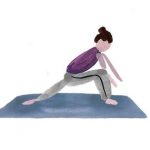In my last post I wrote about the Yamas and Niyamas, from Patanjali’s Yoga Sutras, which are the moral and ethical guidelines yogis follow. I focused on Ahimsa which literarily translates to non-violence. However on a day to day basis, it means treating yourself and all living things with compassion and kindness.
This month I wanted to bring to your attention one of the niyamas: Svadhyaya. It translates as the study of the self. It has a really practical element for anybody who feels they want to assess where they are in their lives or more regularly and in turn improve themselves.
There are two interpretations of Svadhyaya. The traditional one is studying the ancient texts like The Yoga Sutras or Bhagavad Gita. In a yoga class context, maybe you have chanted the mantra Om? The idea behind chanting a mantra is that your mind is concentrating on that chant and all other thoughts fall away. So you are then in the present moment, sitting still with yourself.
The second interpretation in my eyes is one that falls into modern day life. We may read self help books or try a new healthy eating plan but a continuous merry go round of trying new things and hoping they work goes against Svadhyaya. If you have read a specific book you need to take the time to digest and think about its’ ideas and concepts. Are they applicable to what you are trying to achieve? Are we giving them the time to work or work out if these new concepts will work for us? Svadhyaya is not just reading lots of books, it is taking the time to reflect on what we have learnt and how it may help us improve ourselves.
Another way to examine Svadhyaya is through our relationships with people. How they react towards us? In close relationships it’s hard to hide our true feelings. They can act as a mirror.
We are often found plodding through daily life on auto pilot. We are creatures of habit and often they are habits difficult to break. They become vicious circles in our weekly regimes and yoga can teach us to stop and change direction. To improve ourselves. Improve our health and wellbeing. Improve our relationships.
Time is key a factor in Svadyhaha. Contemplation allows us to reflect on what we have learnt through something we’ve read or an interaction with someone else. Being present is another factor. Questioning what you are doing and why you are doing it? Is it just habit? What we do as humans and what we think, affects not just us, but all those around us and around the world. Through yoga we study ourselves on the mat but also become aware of where we sit in the wider universe.
All these questions will always bring us into the present moment. We are all guilty of not being honest with ourselves. Sometimes we are not ready to be, however honesty can bring self-realisation.
Hari Prasad Shastri words sum up Svadhyaya perfectly for me: ‘ The most important thing in life is neither marriage, nor a degree at a university, nor living in comfort and plenty. It is the will to learn. Unless we learn great lessons in life, we vegetate and fail to accomplish the purpose of life. The region of consciousness is infinite; the sea of our mind is replete with priceless pearls. To live is to expand the horizon of our life and to discover the pearls of knowledge daily.’

Svadhyaya mantra exercise
The So Hum meditation is an easy way to start to focus on being in the present moment. It translates as ‘I am that’, meaning the wider universe.
Sit quietly on the floor, a chair, a cushion or up against a wall for support, just wherever and however is comfortable for you. Place you hands in your lap or on your legs, palms facing up and close your eyes.
Take a moment to body scan and just clock if there’s any tension that needs to be released. Sitting upright, start to notice your breathing pattern. The inhalation and then the exhalation. As your mind settles, silently say ‘So’ on the inhale and silently say ‘Hum’ on the exhale.
If a thought arises and distracts you, acknowledge it and then come back to the ‘So Hum’ mantra and the awareness of your breath.


